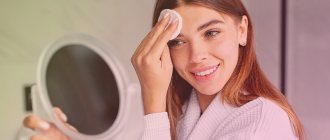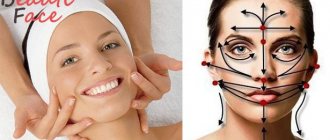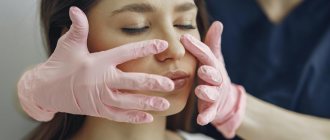| Langer lines | |
| Identifiers | |
| TA98 | A16.0.00.008 |
| TA2 | 7045 |
| F.M.A. | 71951 |
| Anatomical terminology [edit in Wikidata] | |
Langer lines
Langer skin tension lines
, or sometimes called
cleavage lines
, are topological lines drawn on a map of the human body. They parallel the natural orientation of collagen fibers in the dermis, as well as the underlying muscle fibers. Langer's lines are relevant to forensic medicine and the development of surgical techniques.
Story
The lines were first discovered in 1861 by the Austrian anatomist Karl Langer (1819–1887),[1][2][3] although he cited the surgeon Baron Dupuytren as the first to recognize the phenomenon. Langer poked many holes a short distance apart in the skin of the corpse using a round-headed instrument similar to an ice pick. He noticed that the resulting punctures on the skin had an elliptical shape. During this testing, he observed patterns and was able to determine "line directions" along the longer axes of the ellipsoidal holes and lines.
The meaning of lines in massage of the face, neck, décolleté
It’s not scary if a woman doesn’t know about the location of massage lines on the skin. But if you take them into account during a facial massage, the results will double. First of all, they can be used while applying the cream: the nutrients will be better absorbed and the natural renewal of the epidermis will begin.
During a massage in these directions, the movement of lymph through the channels occurs more freely, which is reflected in the condition of the skin and its color.
The technique is safe, since the skin along these areas is less susceptible to stretching. It is important to determine the lines for facial massage and work them with the necessary effort. The only thing to avoid is dirty hands, strong pressure, rubbing.
application
Knowing the direction of Langer's lines in a certain area of the skin is important during surgical operations, especially cosmetic ones. If the surgeon has a choice about where and in what direction to make the incision, he or she may choose to make an incision in the direction of Langer's lines. Incisions made parallel to Langer's lines may heal better and leave less scarring than incisions made across them. Conversely, incisions perpendicular to Langer's lines tend to shrink and remain obvious, although this is sometimes unavoidable. The orientation of puncture wounds relative to Langer's lines can significantly affect the appearance of the wound. [4]
Keloids are more common when the incision is made along Langer's line. [ citation needed
] Sometimes the exact direction of collagen fibers is unknown because there are differences between different people in some areas of the body. In addition, the lines described by Kreissl differ in some ways from Langer's lines, especially on the face.
Langer lines
Science has known for quite some time about the existence of such a substance as collagen. These are protein threads present in connective tissue, namely in the intercellular substance. Collagen provides firmness and elasticity to fibers. This substance forms peculiar bundles. Langer lines are located in their direction.
History of discovery and subsequent research
In 1861, German anatomist Karl Langer published his work “On the Anatomy and Physiology of the Skin. On the splitting of the skin." It was in it that he described the presence of conditionally drawn lines on the surface of the skin, along which it is most extensible.
Langer studied the properties of skin, such as elasticity, and noticed that skin is more stretchable in some directions than in others. He associated this phenomenon with the placement of collagen bundles under the skin in these places. The scientist stated that in different places of the body, elastic fibers have different directions.
Along the Langer lines (cleavage lines) the strength of the skin is much higher. The scientist established this experimentally, using skin on corpses. In our time, researchers have tried to provide more accurate data about this phenomenon by doing experiments on animal skin. Of course, animal skin is significantly different from human skin. Therefore, the information obtained in this way left many questions.
Scientists at University College Dublin in Ireland and personally Professor Aisling Ni Annaidh tried to obtain more accurate information. To conduct research, they needed about fifty-six skin fragments (taken from cadaveric material).
These studies confirmed Langer's hypotheses, but the question of the origin of this phenomenon remained open. This is probably simply a matter of the forces that act when attaching the skin to the body, but it could also be an anatomical phenomenon. That is, it is possible that the skin itself has hidden structures that form Langer's lines.
The main conclusion from all the studies of this phenomenon can be the fact that the existence of Langer lines simply needs to be taken into account by many specialists in different fields. From surgery to cosmetology, for the most effective effect on the skin you need to know the specifics of Langer's lines.
Langer lines on the face
To reduce the consequences after operations, including plastic ones, as well as for more effective work of a cosmetologist, it is necessary to know where exactly the Langer lines are located on the face.
These lines on the face are located as follows:
- Along the line from the chin to the earlobes.
- From the corners of the lips to the middle of the ears.
- From the wings of the nose to the upper tips of the ears.
- From the middle of the nose to the temples.
- On the nose: from the tip of the nose to the bridge of the nose along the back and from the back of the nose to the wings.
- Upper eyelid: in a semicircle from the inner corner of the eyelid to the outer.
- Lower eyelid: in a semicircle from the outer corner of the eyelid to the inner.
- Forehead: from the middle of the forehead to the temples; from the eyebrow line vertically upward to the hairline.
- Neck: The front surface of the neck has an arrangement of fibers from bottom to top, while the side surface has fibers from top to bottom.
It is not so difficult to remember the location of these lines, but they should definitely be taken into account when cleansing your face and removing makeup, and even when applying make-up. These procedures should be carried out strictly in the direction of these lines, avoiding stretching the skin. Applying makeup to the surface of the nose is from the wings vertically to the base of the nose, and starting from the forehead, change the direction towards the temples.
The skin around the eyes is the thinnest and should never be stretched when applying or removing makeup. It is better to rub in the products with patting movements, and remove makeup with circular massage movements. Applying cosmetics to the face should occur along stretch lines, which will keep the skin more elastic. Proper care prevents the appearance of wrinkles.
Langer lines on the body and head
It is obvious that collagen bundles are located in a certain direction not only on the face, but throughout the body. For a better understanding, you should consider the drawing.
Langer's lines on the body are usually located in places where the skin naturally folds, since they are directed perpendicular to the muscles so that when the muscles are tense, the collagen bundles are not damaged. As we can see, Langer's lines are located horizontally on the hands, parallel to each other. Also in the center of the back and on the back of the legs. The lines run parallel to the ribs, bend around the pectoral muscles in front and the shoulder blades in the back. On the buttocks, directed from the center to the edges from bottom to top. On the front of the leg above the knee, the lines are located vertically. All these features are usually taken into account by surgeons during operations, massage therapists and cosmetologists.
When we need to determine the location of Langer's lines in places where there are no natural folds or wrinkles, we can do the following: squeeze an area of skin with your fingers, first along and then across. If skin folds appear, then Langer's lines are located there; if the surface is smooth, this area does not correspond to the direction of the lines.
Langer's lines are located not only on the face, but throughout the head. Their location is important to consider when undergoing hair transplantation, for example.
Langer's lines in the upper half of the forehead are parallel to the hairline:
- Approximately at eye level, a horizontal line goes around the back of the skull.
- Between this line and the hairline there are lines perpendicular to them that go around the skull.
- Between this same line and the horizontal line separating the area of hair growth and the neck, there are the same lines perpendicular to them, encircling the skull. For a better understanding, you should pay attention to the figure below.
Science has known about the existence of Langer lines for more than one hundred and fifty years. This knowledge is actively used by cosmetologists around the world, and, of course, by surgeons. Considering this phenomenon, it is possible to more effectively influence the skin and slow down the appearance of wrinkles.
When the skin is exposed without taking this factor into account, the collagen bundles are more likely to wear out. As a result, the elasticity of the skin decreases, it ages faster and wrinkles appear earlier. Everyone needs knowledge about Langer's lines in everyday life in order to properly care for their skin.
It is also necessary to remember that it is important to apply cosmetics not only along massage lines (Langer lines), but also at a certain time. The skin has its own biorhythms when it is best suited for cosmetic procedures. More information about skin biorhythms is written on the pages of the Aesthetic Portal.
Anna BUNYAK
Download WordPress Themes
Free Download WordPress Themes
Download Premium WordPress Themes Free
Download Best WordPress Themes Free Download
free download udemy paid course
CollagenMassage
Self-massage technique for the face from Elena Zemskova
Elena Zemskova is the founder and director of the Moscow school “Chiromassage IQ”. Her methods are based on the latest advances in the field of anatomy, neurology and psychology. The school has representative offices in Russia, Israel, Latvia, Lithuania, and Estonia.
According to Elena’s method, massage is carried out in several stages:
- Soft stroking, leading to activation of the nervous system, transmitting excitement to the vascular and muscle tissue of the massaged area.
- Kneading the deeper layers with your fingertips to influence the lymphatic and blood vessels.
- Final passes with the phalanges of the fingers to improve the functioning of the muscular system.
Skin activation is carried out exclusively through massage lines. The movements are performed rhythmically, without strong pressure, avoiding pain. After working through the zone, the movement is fixed at the end of the line for 1-2 seconds.
The school offers three types of facial massage. The first is a short universal express lifting that allows you to quickly restore tone. The second is differentiated corrective massage. The third is decongestant lymphatic self-massage.
Gymnastics for the face of Anastasia Burdyug: a set of exercises with photos and videos
Discussion: 3 comments
- Alla:
05/31/2019 at 12:16 pmI think if a woman is over 40, then such a massage is simply a must. I do it systematically and the skin on my face has become much healthier and more elastic, I like the way I look now.
Answer
- Natalia:
05/25/2019 at 11:52 am
Over the last couple of months I started giving myself this massage, I am delighted, I see that the condition of my skin has improved much.
Answer
- Elena:
05/20/2019 at 6:07 pm
I repeatedly did this massage for myself, but with a specialist, where I really got the desired effect, after all, the person has the correct massage technique, I would not have been able to do that.
Answer
Line layout
Information about where the facial massage lines are located is a must. Many photos in beauty clinics and fashion magazines will help you understand the exact technology. The diagram of massage lines is a template, on the basis of this the location of your zones is determined, they are marked with a cosmetic pencil. Not only the face is affected, but also the chin, neck, décolleté: every area is important. A classic facial massage will bring more benefits if you take into account the location of the massage lines on the face, and everyday self-care procedures will double the effect.
How to properly apply cream to face and neck
The cream is applied to clean, warm and slightly damp skin. Clean the massaged area with micellar water, hydrophilic oil, mousses and lotions, and two-phase products. Vitamin tonic is suitable for rinsing. Before performing the massage, part of the nourishing care composition is rubbed into the fingertips.
The amount of product applied is selected individually. An insufficient dose will not be effective, an excessive dose will clog the skin pores and create a specific film. Special delicate creams are used to care for the eye area; the décolleté area can be treated with regular body cream. In this area, massage is done by lightly tapping with the ring fingers.
After applying the cream, you need to let the product absorb. Usually 15-20 minutes are enough for this.
Procedure for facial massage
Among the various types of massage, the most popular is classic cosmetic massage. Its tasks are reduced to maintaining a healthy appearance and skin tone. As a rule, it is carried out twice: at the beginning of the day and at night. A combination of massage movements and special care products works ideally. In the morning, various tonic and protective compositions are good, and before bed - nutritional mixtures.
Massage along Langer's lines gives the following results:
- skin tightening and stabilization of the resulting facial contour;
- normalization of lymph outflow;
- optimization of nutrient supply and innervation of the skin;
- increasing skin firmness and elasticity;
- disappearance of facial and age-related folds;
- stopping the appearance of new wrinkles.
Unlike professional therapeutic and plastic types of massage, classical techniques can be performed by any woman.
If the massage is carried out without applying creams, special oils can be used to enhance the effect. Walnut and apricot oils are good for all skin types. Avocado or wheat germ oil is suitable for dry skin. For normal use olive oil. For oily people - oil based on St. John's wort or jojoba.











